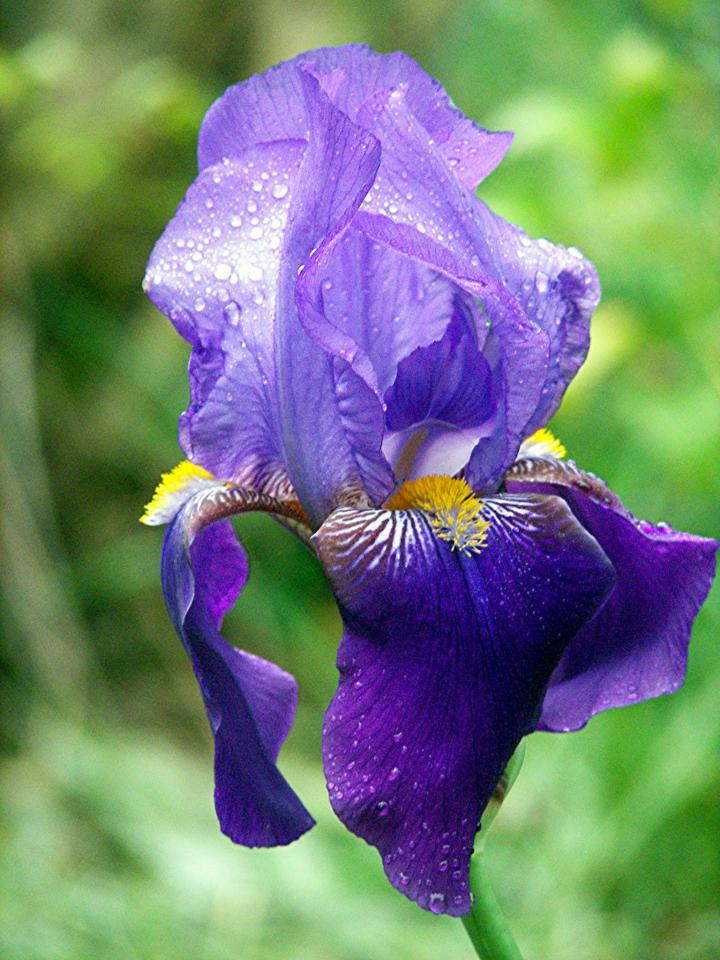 BA Elliott
BA Elliott
The tall, beautiful iris, named after the Greek goddess who rode rainbows, comes in many magical colors.
Every gardener wants this perennial. Despite its divine origins, it is hardy, reliable, and easy to grow. Irises also attract butterflies and hummingbirds and make lovely cut flowers.
There are some 300 species in the genus Iris. The most familiar irises are the tall (at least 28 inches) bearded irises (Iris germanica).
The distinctive flowers have three large outer petals called “falls” and three inner upright petals called “standards.” The falls may have beards or crests. Bearded iris are so-called because they have soft hairs along the center of the falls. In crested iris, the hairs form a comb or ridge.
Most irises flower in early summer. Some, mostly bearded hybrids, are remontant, flowering again later in the summer.
Planting
- Irises need at least half a day of sun and well-drained soil. Without enough sun, they won’t bloom.
- They prefer fertile, neutral to slightly acidic soil. If your soil is very acidic, sweeten it with a bit of lime, and forbear summer watering, which can lead to rot.
- Bearded irises must not be shaded by other plants; many do best in a special bed on their own.
- Soil drainage is very important. Loosen the soil with a tiller or garden fork to a depth of 12 to 15 inches, then mix in a 2- to 4-inch layer of compost.
- Plant iris in mid- to late summer.
- Bearded irises have rhizomes (fleshy roots) that should be partially exposed, or thinly covered with soil in hot climates.
- Plant rhizomes singly or in groups of three with the fans outermost, 1 to 2 feet apart, depending on the size.
- Dig a shallow hole 10 inches in diameter and 4 inches deep. Make a ridge of soil down the middle and place the rhizome on the ridge, spreading roots down both sides. Fill the hole with soil and firm it gently.
- Water thoroughly.
- When planting, top-dress with a low-nitrogen fertilizer, and again in early spring.
Care
- Avoid applying high-nitrogen fertilizers to the surface or carelessly mulching with organic matter, which may encourage rhizome rot.
- Keep rhizomes exposed. Unlike bulbs, which thrive deep underground, iris rhizomes need a bit of sun and air to dry them out. If they’re covered with soil or crowded by other plants, they’ll rot. Irises may benefit from shallow mulching in the spring.
- Don’t trim iris leaves. Leaves carry on photosynthesis for next year’s growth. Cut off brown tips—and cut the flowering stalk down to the rhizome to discourage rot.
- If iris foliage is hit with heavy frost, remove and destroy it to eliminate borer eggs.
- After 2 to 5 years, when clumps become congested or lose vitality, divide and replant sound rhizomes in fresh soil. The best time to replant irises is soon after bloom. Transplant them to places where they will have “wet feet but dry knees.”
Pests/Diseases
Irises are deer-resistant and drought-tolerant. However, they are susceptible to borers, so check the rhizomes (fleshy roots) yearly for holes, discarding any infested ones.
Verbena bud moth, whiteflies, iris weevil, thrips, slugs and snails, aphids, and nematodes may also be troublesome.
Recommended Varieties
- ‘Immortality’ is a tall bearded flower that offers pure white flowers and reblooms in the fall. Grows best in Zones 4 to 9.
- Other rebloomers, hardy at least to Zone 4, are: ‘Feed Back’, a dark purple; ‘Earl of Essex’, also purple; and ‘I Do’, with white flowers.
- If you live in Zone 5 or warmer, try ‘Jennifer Rebecca’, a mauve pink beauty.
- ‘Siberian Irises’ also come in a range of colors and are distinct from the more common bearded irises.
Wit & Wisdom
- The iris is the French royal standard fleur-de-lis and also the symbol of Florence, Italy.
- Oral root, taken from the dried roots of Iris ‘Florentia’, was considered a cure for blood and lung diseases, and teething babies were encouraged to gnaw on a “finger” of dried root for its natural fluoride.






 BA Elliott
BA Elliott